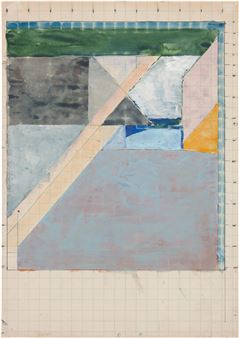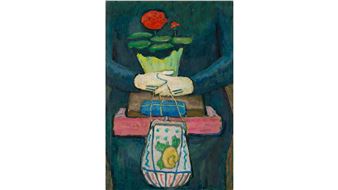Duane Hanson's Chinese Student, 1989
Beginning in the late 1960s with such sculptures as War, Gangland Victim, and Bowery Derelicts, Duane Hanson tackled timely social subjects in a brutally realist manner, elevating social and political issues to an iconic level. In 1970, Hanson evolved both in terms of his style and subject matter to create more subtle investigations of character: that of the everyday people he encountered. Among the first artists to work in a hyper-realist style, Hanson is often associated with Pop Art and at other times with Photorealism. Cast from life, dressed in second-hand clothing, and accessorized with found objects, Hanson’s sculptures were a radical return to figuration in the wake of recent abstraction. As was the case with all of his models, Hanson called on relatives and friends to pose for him for the grueling process of being cast piece-by-piece, body part by body part. The model for Chinese Student was Hanson’s own studio assistant, Tin Ly, who worked with him for many years, and was a close friend of the Hanson family.
In Chinese Student, Hanson melds the personal and political. An ordinary student, turned political activist, sits on the ground holding a protest sign, wearing a bandana emblazoned with a slogan for his cause. He is not the ardent, screaming protestor we have seen on the news, but is captured in a moment of weary reflection and is utterly human. Hanson allows us the unusual privilege of staring, prompting us to confront the hard truth of the struggle of others.
Beginning in the late 1960s with such sculptures as War, Gangland Victim, and Bowery Derelicts, Duane Hanson tackled timely social subjects in a brutally realist manner, elevating social and political issues to an iconic level. In 1970, Hanson evolved both in terms of his style and subject matter to create more subtle investigations of character: that of the everyday people he encountered. Among the first artists to work in a hyper-realist style, Hanson is often associated with Pop Art and at other times with Photorealism. Cast from life, dressed in second-hand clothing, and accessorized with found objects, Hanson’s sculptures were a radical return to figuration in the wake of recent abstraction. As was the case with all of his models, Hanson called on relatives and friends to pose for him for the grueling process of being cast piece-by-piece, body part by body part. The model for Chinese Student was Hanson’s own studio assistant, Tin Ly, who worked with him for many years, and was a close friend of the Hanson family.
In Chinese Student, Hanson melds the personal and political. An ordinary student, turned political activist, sits on the ground holding a protest sign, wearing a bandana emblazoned with a slogan for his cause. He is not the ardent, screaming protestor we have seen on the news, but is captured in a moment of weary reflection and is utterly human. Hanson allows us the unusual privilege of staring, prompting us to confront the hard truth of the struggle of others.
Artists on show
Contact details


 ARTISTS
ARTISTS










